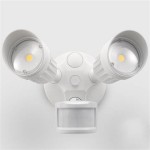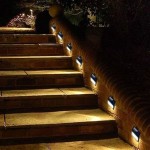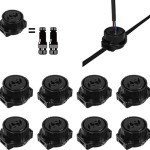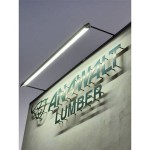What Are The Best Outdoor Sensor Lights?
Outdoor sensor lights are an essential component of home security and convenience. They provide illumination when motion is detected, deterring potential intruders and offering enhanced visibility for navigating properties at night. Selecting the "best" outdoor sensor lights requires considering various factors, including the type of light, sensor technology, power source, and overall durability. This article explores the key aspects of outdoor sensor lights to guide informed purchasing decisions.
Understanding Types of Outdoor Sensor Lights
Outdoor sensor lights are available in several configurations, each with advantages and disadvantages. The most common types include floodlights, spotlights, and pathway lights, each designed for specific illumination needs.
Floodlights: Floodlights are designed to cast a wide beam of light over a broad area. They are typically mounted high on walls or under eaves to illuminate large yards, driveways, or parking areas. Floodlights often utilize powerful light sources, such as LEDs or halogen bulbs, to provide ample brightness. The wide coverage makes them well-suited for security applications, deterring potential intruders by exposing them to bright light.
Spotlights: Spotlights, in contrast to floodlights, produce a focused beam of light. They are ideal for highlighting specific features of a property, such as landscaping, architectural details, or entryways. Spotlights can also be used for security, focusing attention on areas where motion is most likely to occur, such as gates or doorways. Their concentrated beam allows for a longer range of illumination compared to floodlights.
Pathway Lights: Pathway lights are designed to illuminate walkways, garden paths, and other pedestrian areas. They are typically smaller and less powerful than floodlights or spotlights, providing a soft glow to guide people safely through the property at night. Pathway lights often incorporate decorative elements, enhancing the aesthetic appeal of the outdoor space. They can be powered by solar energy or low-voltage electricity.
The choice between these types depends entirely on the specific needs of the property. A large, open area might benefit most from floodlights, while a landscaped garden could be better served by spotlights and pathway lights.
Evaluating Sensor Technology
The effectiveness of an outdoor sensor light hinges on the sensitivity and reliability of its sensor. Two primary types of sensors are commonly used: passive infrared (PIR) and microwave sensors. Each technology employs a different method for detecting motion.
Passive Infrared (PIR) Sensors: PIR sensors detect changes in infrared radiation emitted by objects in their field of view. All objects with a temperature above absolute zero emit infrared radiation. When a warm object, such as a person or vehicle, moves into the sensor's range, the change in infrared radiation triggers the light. PIR sensors are relatively inexpensive and widely used, making them a popular choice for residential applications. However, their performance can be affected by ambient temperature, potentially leading to false triggers on hot days.
Microwave Sensors: Microwave sensors emit microwave radiation and detect changes in the reflected signal. When an object moves within the sensor's range, it alters the reflected microwaves, triggering the light. Microwave sensors are generally more sensitive than PIR sensors and are less susceptible to false triggers caused by temperature fluctuations. They can also detect motion through walls and other non-metallic objects. However, they tend to be more expensive and may be prone to false triggers from other sources of microwave radiation.
Factors to consider when evaluating sensor technology include the detection range, sensitivity, and adjustability. A longer detection range allows the light to activate from a greater distance. Adjustable sensitivity settings can help minimize false triggers. Some models also offer adjustable timers, allowing users to set how long the light remains on after motion is detected.
Power Source Options and Considerations
Outdoor sensor lights are available with various power source options, including hardwired, battery-powered, and solar-powered models. Each option presents its own advantages and disadvantages in terms of installation, cost, and reliability.
Hardwired Lights: Hardwired lights are connected directly to the home's electrical system. They provide a reliable and consistent source of power, ensuring that the lights are always ready to activate when motion is detected. Hardwired lights typically require professional installation, adding to the overall cost. However, they eliminate the need for battery replacements and provide a more robust and secure lighting solution.
Battery-Powered Lights: Battery-powered lights offer greater flexibility in terms of placement, as they do not require access to the electrical grid. They are easy to install and can be moved as needed. However, battery-powered lights require regular battery replacements, which can be costly and inconvenient. The brightness and performance of battery-powered lights may also diminish as the batteries deplete.
Solar-Powered Lights: Solar-powered lights are powered by the sun, making them an energy-efficient and environmentally friendly option. They are easy to install and require no wiring. However, the performance of solar-powered lights depends on the amount of sunlight they receive. In areas with limited sunlight, their brightness and reliability may be compromised. Solar-powered lights also typically have lower light output compared to hardwired or battery-powered models.
The choice of power source depends on the specific needs of the property and the availability of sunlight or electrical infrastructure. Hardwired lights are ideal for providing reliable security lighting, while battery-powered and solar-powered lights offer greater flexibility for areas where wiring is not feasible.
Durability and Weather Resistance
Outdoor sensor lights are exposed to the elements, so durability and weather resistance are crucial considerations. Look for lights constructed from robust materials that can withstand rain, snow, and extreme temperatures. The Ingress Protection (IP) rating indicates the level of protection against dust and water ingress. A higher IP rating signifies greater protection.
Lights intended for outdoor use should have an IP rating of at least IP44, which provides protection against splashing water. For areas exposed to heavy rain or direct water spray, an IP rating of IP65 or higher is recommended. Materials such as aluminum, stainless steel, and durable plastics are commonly used in outdoor light fixtures. These materials offer good resistance to corrosion and weathering.
The lens of the light should also be made from a durable material, such as tempered glass or polycarbonate, to withstand impacts and prevent cracking. Consider the operating temperature range of the light to ensure that it can function reliably in the local climate.
Light Output and Color Temperature
The brightness of an outdoor sensor light is measured in lumens. The required lumen output depends on the size of the area being illuminated and the desired level of brightness. For general security lighting, a lumen output of 700-1300 lumens is often sufficient. Larger areas may require lights with higher lumen outputs.
Color temperature, measured in Kelvin (K), describes the warmth or coolness of the light emitted. Lower color temperatures (2700-3000K) produce a warm, yellowish light, while higher color temperatures (4000-5000K) produce a cool, white light. For security applications, cool, white light is often preferred as it provides better visibility and clarity. However, warm light may be more aesthetically pleasing for accent lighting or pathway lighting.
Consider the color rendering index (CRI) of the light source, which indicates how accurately the light renders colors compared to natural sunlight. A higher CRI value indicates better color rendering. For outdoor lighting, a CRI of 80 or higher is generally recommended.
Installation Considerations
Proper installation is essential for the optimal performance and longevity of outdoor sensor lights. Hardwired lights typically require professional installation to ensure that they are properly connected to the electrical system and comply with local building codes. Battery-powered and solar-powered lights are generally easier to install and can be done by homeowners. However, it is important to follow the manufacturer's instructions carefully.
Consider the mounting location of the light. Lights should be positioned to provide maximum coverage and avoid obstructions. Ensure that the sensor has a clear line of sight to the area it is intended to monitor. Avoid placing lights near heat sources or areas with high levels of foot traffic, as this can lead to false triggers.
When installing hardwired lights, disconnect the power to the circuit before beginning work. Use appropriate wiring techniques and ensure that all connections are secure. Follow local electrical codes and regulations.
Maintenance and Troubleshooting
Outdoor sensor lights require minimal maintenance. Regularly clean the lens and sensor to remove dirt and debris. Check the wiring and connections periodically to ensure that they are secure. Replace batteries as needed and dispose of them properly.
If the light is not functioning properly, check the following: ensure that the power is on, the sensor is clean, and the batteries are fresh (if applicable). Check the wiring connections for any loose or damaged wires. Adjust the sensor sensitivity and timer settings. If the problem persists, consult a qualified electrician.
Smart Features and Integration
Many modern outdoor sensor lights offer smart features and integration with other smart home devices. These features can enhance functionality and convenience. Some lights offer remote control via a smartphone app, allowing users to adjust settings, schedule on/off times, and receive notifications when motion is detected.
Integration with smart home platforms, such as Amazon Alexa or Google Assistant, allows users to control the lights with voice commands. Some lights can also be integrated with security systems, triggering alarms or sending alerts when motion is detected. Consider the compatibility of the light with existing smart home devices.
Budget and Value
Outdoor sensor lights are available at a wide range of price points. The cost depends on the type of light, sensor technology, power source, durability, and smart features. Consider the long-term cost of ownership, including battery replacements or electricity consumption. Investing in a high-quality, durable light may be more cost-effective in the long run.
Compare prices from different retailers and look for sales or discounts. Read reviews from other users to get an idea of the light's performance and reliability. Choose a light that offers the best balance of features, performance, and value for the specific needs of the property.

The Best Outdoor Motion Sensor Lights In 2024 Popular Science

10 Best Ing Outdoor Motion Sensor Lights For 2024 The Jerum Post
The Best Outdoor Motion Sensor Lights To Keep Your Home Secure

Best Outdoor Motion Sensor Lights 2024 Security

7 Best Outdoor Motion Sensor Lights Of 2024 Tested And Reviewed By Bob Vila

Best Outdoor Motion Sensor Lights 2024 Security

7 Best Outdoor Motion Sensor Lights Of 2024 Tested And Reviewed By Bob Vila

The Best Outdoor Motion Sensor Lights In 2024 Popular Science

Best Ing Solar Motion Sensor Light For 2024 The Jerum Post

9 Best Security Lights With Motion Sensor Deluxe House
Related Posts







